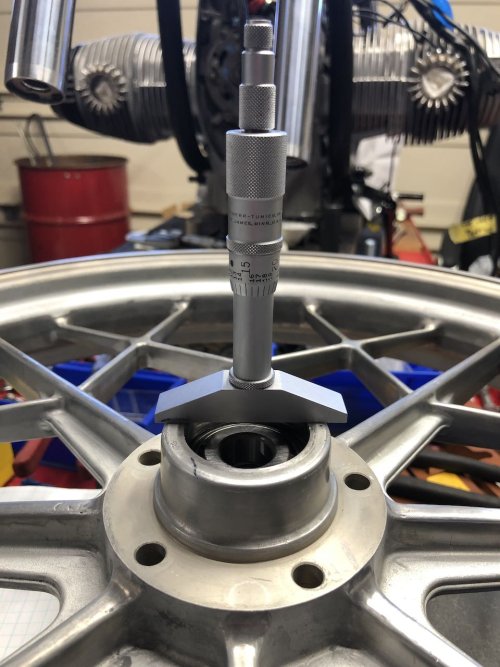gtgt_bangbang
New member
Not sure I have the patience or the fixturing to do my first guess of proper "pre load spacer" in the usual process ; namely "assemble the wheel with best guess shimming and weigh the break free loading with strings and scale."
I probably still do that as a final check, but sure seems there is a physical INTERFERENCE range that would get the preload real close ,
and not all that difficult to do with the wheel on a bench.
My question is ; does anyone have a value for the the interference range , in other words how much " crush" is correct for proper bearing preload?
The Crush in DISTANCE, not break free load ...
I figure proper interference / crush will be nothing less than zero (must have actual contact through entire spacer stack ), and upper tolerance at some extremely small interference value.
I plan to swap in various shims while measuring the upper bearing recess, the depth in hub , with a depth mic , to find when it raises a fraction of a mil off its race.
Not clear? as if MORE words will help, ;
I drove both bearings outer races in , with the original distance piece & wedding ring inside ( I'll skip heating the hub next time; its useless with that steel hub liner , but it did help melt some of the distance piece plastic spools, so now the distance piece will be a little sloppy , come time to insert axle...
I set the wheel horizontal on a stable flat surface , with inner bearings inserted , and with a socket under the bottom side bearing to force it up in the race, seated like normal. iow, The wheel is sitting horizontal and able to spin on the lower side bearing.
Then , I measure how "recessed" the inner race of the TOP bearing is in the hub.... ( a depth micrometer will do great , or calipers on a stiff bridge across the counter bore.)
Now try various shims until the upper bearing rises just barely rise off the race. I figure a fraction of a .001 would be enough crush ....sure would like ot know though ...
This is working cos at the start of my set up, using only the old spacer & wedding ring with the new bearings, it is obvious the the spacer stack is NOT in contact with both bearings, so I need to add stack height , iow, my spacer stack is starting with a tiny bit of a gap.
knowing that bearing life is much better when slightly OVER (pre) LOADED (some small positive interference) than UNDER pre LOADED ( no interference, a slop condition), Ill err on the side of higher crush , need be.
The proper crush should be measureable, ANY ONE KNOW IT ? many thanks
I probably still do that as a final check, but sure seems there is a physical INTERFERENCE range that would get the preload real close ,
and not all that difficult to do with the wheel on a bench.
My question is ; does anyone have a value for the the interference range , in other words how much " crush" is correct for proper bearing preload?
The Crush in DISTANCE, not break free load ...
I figure proper interference / crush will be nothing less than zero (must have actual contact through entire spacer stack ), and upper tolerance at some extremely small interference value.
I plan to swap in various shims while measuring the upper bearing recess, the depth in hub , with a depth mic , to find when it raises a fraction of a mil off its race.
Not clear? as if MORE words will help, ;
I drove both bearings outer races in , with the original distance piece & wedding ring inside ( I'll skip heating the hub next time; its useless with that steel hub liner , but it did help melt some of the distance piece plastic spools, so now the distance piece will be a little sloppy , come time to insert axle...
I set the wheel horizontal on a stable flat surface , with inner bearings inserted , and with a socket under the bottom side bearing to force it up in the race, seated like normal. iow, The wheel is sitting horizontal and able to spin on the lower side bearing.
Then , I measure how "recessed" the inner race of the TOP bearing is in the hub.... ( a depth micrometer will do great , or calipers on a stiff bridge across the counter bore.)
Now try various shims until the upper bearing rises just barely rise off the race. I figure a fraction of a .001 would be enough crush ....sure would like ot know though ...
This is working cos at the start of my set up, using only the old spacer & wedding ring with the new bearings, it is obvious the the spacer stack is NOT in contact with both bearings, so I need to add stack height , iow, my spacer stack is starting with a tiny bit of a gap.
knowing that bearing life is much better when slightly OVER (pre) LOADED (some small positive interference) than UNDER pre LOADED ( no interference, a slop condition), Ill err on the side of higher crush , need be.
The proper crush should be measureable, ANY ONE KNOW IT ? many thanks
Last edited:




